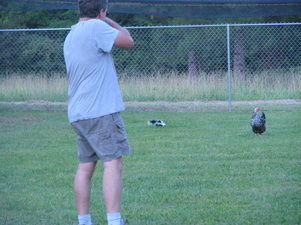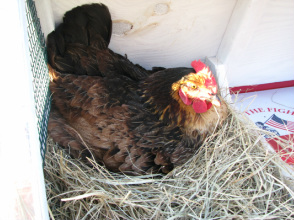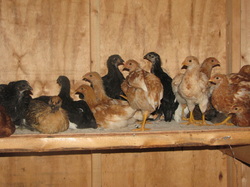
This afternoon as I was checking on my chickens, I looked down toward the end of the pen and there was a fuzzy black and white object. I immediately recognized it as a skunk and ran back to the house for my camera and my husband. I wanted to shoot a picture and I wanted my husband to shoot the skunk. Husbands are good for things like this.
After we tied the dog up to the house (because the dog gets in the middle of the action) we headed back up the hill. As my husband entered the pen, he didn't know I was going to take this picture so he didn't wait for me to focus. Did he get the skunk? You bet, and on first shot! He was using a 10/22. The chicken standing in the picture was a bit rattled when the gun went off so she quickly scampered out of sight and all the hens and the rooster were quite upset about it too as there was much cackling after the shot. In fact those who were already perched for the night came down and out to see what all the commotion was about. Now after the shot, I probably do not need to tell you what happened next. The stench that followed had the ability to curl your nose hairs. My husband got a shovel and carried the skunk off. In the house now, we can still smell the critter.
Skunks may kill and eat domestic poultry and their eggs. They pose only a little threat to adult birds, but prize eggs as a tasty treat and will often break up a nest when the opportunity avails itself.
They normally do not climb fences to get poultry. If skunks gain access, they will normally feed on the eggs and occasionally kill one or two fowl. Many times the skunk will remove the head from the chicken to drink the blood. Eggs usually are opened on one end with the end crushed inward.
Source: http://www.backyardchickens.com/a/skunk-chicken-predators-how-to-protect-your-chickens-from-skunks
After we tied the dog up to the house (because the dog gets in the middle of the action) we headed back up the hill. As my husband entered the pen, he didn't know I was going to take this picture so he didn't wait for me to focus. Did he get the skunk? You bet, and on first shot! He was using a 10/22. The chicken standing in the picture was a bit rattled when the gun went off so she quickly scampered out of sight and all the hens and the rooster were quite upset about it too as there was much cackling after the shot. In fact those who were already perched for the night came down and out to see what all the commotion was about. Now after the shot, I probably do not need to tell you what happened next. The stench that followed had the ability to curl your nose hairs. My husband got a shovel and carried the skunk off. In the house now, we can still smell the critter.
Skunks may kill and eat domestic poultry and their eggs. They pose only a little threat to adult birds, but prize eggs as a tasty treat and will often break up a nest when the opportunity avails itself.
They normally do not climb fences to get poultry. If skunks gain access, they will normally feed on the eggs and occasionally kill one or two fowl. Many times the skunk will remove the head from the chicken to drink the blood. Eggs usually are opened on one end with the end crushed inward.
Source: http://www.backyardchickens.com/a/skunk-chicken-predators-how-to-protect-your-chickens-from-skunks


